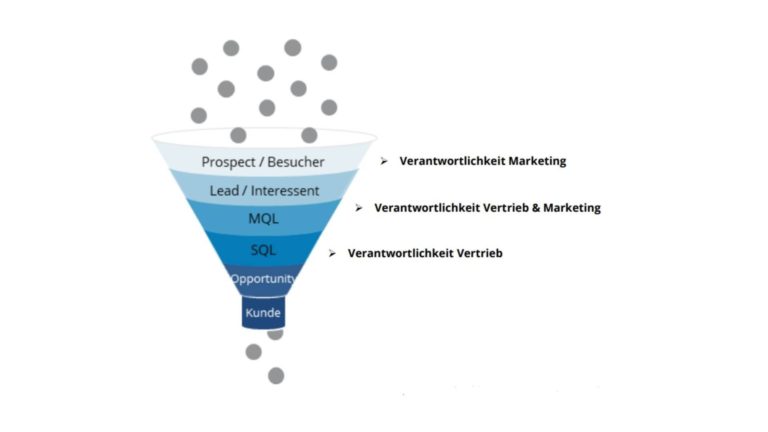Lead Generation
The supreme discipline - lead generation in B2B sales and marketing
But what does it mean to generate a lead?
Lead generation is the process that turns potential customers into clearly identifiable prospects. But the way up to onequalified and thus a correspondingly valuable contact is anything but easy.
The visitors of a website or homepage usually become aware of the corresponding page via search engines, social media, recommendations, articles or similar. They then search them for interesting information with the aim of finding answers to their questions and challenges. As a result, you will be prompted to act, for example by a button that points to an interesting source of information, e.g. a book/e-book or a newsletter. The visitor clicks on it and gets to a so-called landing page with the aim that the interestedHis contact informationleaves and in return receives a so-called Content Offer (information offer that offers added value) as a download.
Attract, interact and inspire
The inbound methodology - marketing, sales & service of the future!
The system of the inbound methodology was created in 2004 through a very simple observation by Brian Halligan and Dharmesh Shah, who realized during their studies that they were in a time of change: Today's people live, work and consume differently than in the past. Today's customers are more empowered than ever. He gathers most of his information himself and doesn't need a salesperson to do so. This gave rise to the guiding principle that customers do not want to be disturbed by providers or salespeople - rather they want to be helped.
The principles of the inbound methodology were born.
By definition it means todayoneoverarching strategy, which includes sales, marketing and customer service. An absolute taboo: The promotion of products, solutions and services. With sophisticated and targeted, digital measures interested parties are informed, enlightened and, ideally, advised at the highest possible level in order to finally make the right purchase decision. Unlike large marketing campaigns, this concept is not reserved for corporations, but offers new opportunities for small and medium-sized companies to address target groups in marketing and sales more efficiently.
The inbound methodology is an optimal means to:
1. to achieve real sales efficiency in acquiring new customers and maintaining existing customers
2. to create a personal appeal and beyond
3. to ensure the measurability of marketing investments
Digitization – changing customer behavior Digital media offer endless information opportunities for both your existing customers and potential customers. The feeling and perception of marketing is also changing. Nowadays we prefer a simple and fast search for information and offers on the Internet. Relevant content can be “googled” quickly and anytime, anywhere. The right products and services are advertised and presented directly. Opinions and recommendations from the environment continue to play an important role in the purchase decision, but here too the exchange often takes place online or in social networks.
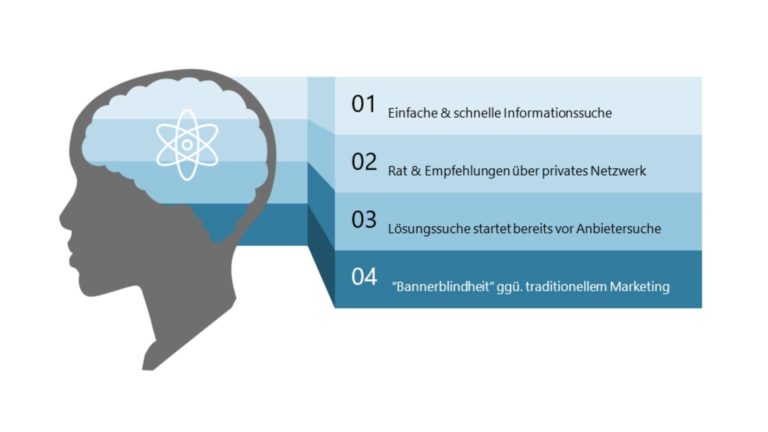
Changed information behavior also in B2B
In B2B, too, the digital information options are used for decision-making. The majority of B2B buyers use digital media to research information and consume an average of ten content offerings during their procurement process. According to a current Roland Berger study, 46% of B2B decision-makers are under 35 years old. No wonder then thatsocial mediaatcontributes over 80% to the decision-making process. You can find more key figures on B2B buyers here
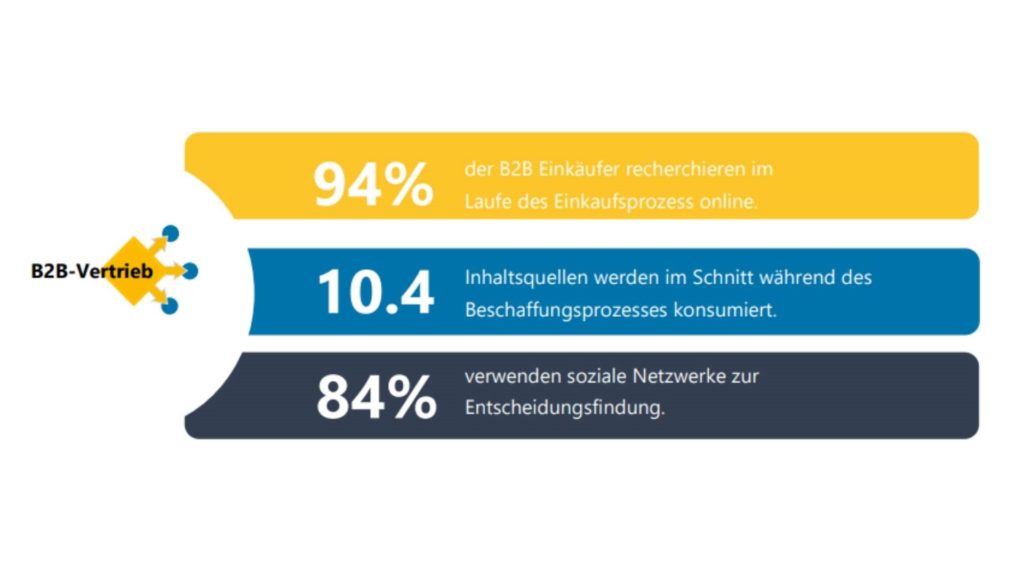
Giving away knowledge – selling solutions
Both you and your customers benefit from this approach of effective and sustainable growth, which includes marketing, sales and customer service in equal measure. By providing the selected target groups with your expertise through relevant information on platforms they already use, you can profile your own company and build a basis of trust with existing and new customers. To do this, you have to put yourself in the shoes of your customers in order to best understand their way of thinking and their buying behavior. The graphic below compares the characteristics of outbound marketing to those of inbound marketing. Conventional outbound marketing is characterized by the push principle, which consists of convincing a visitor to buy a product or service using measures that are sometimes "disruptive", such as obtrusive advertising pop-up windows.
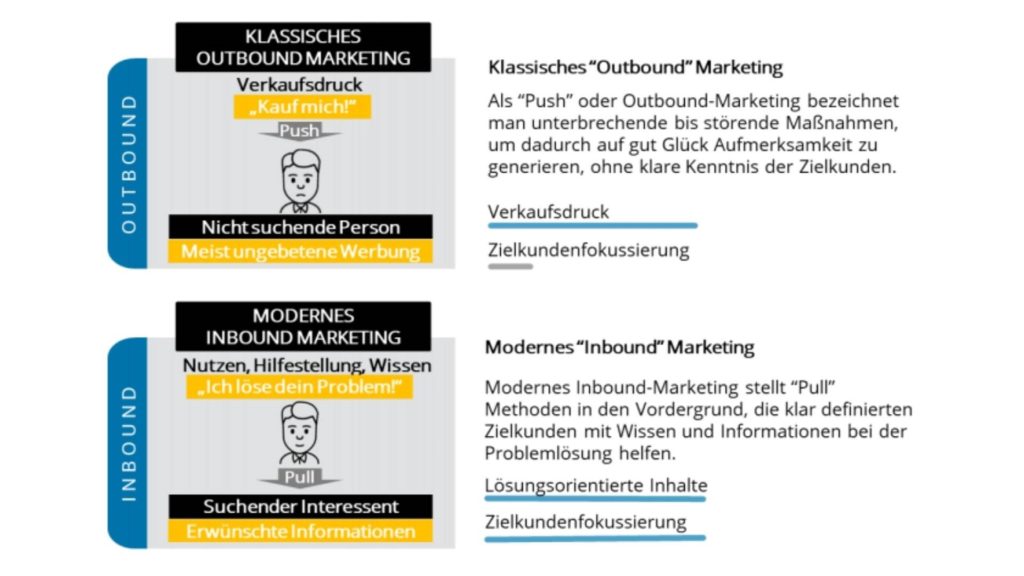
Change the way you communicate from pure product information to finding solutions!
Similar to a visit to a clothing store, the visitor to your homepage probably only wants to look around at first. Push measures ("push measures") have an intrusive effect and thus tend to trigger annoyance and counteract the desired effect, namely building trust through further information.inbound marketingis characterized by the pull principle ("principle of attraction"). Your potential customers are already looking for a solution and often look for specific products on the Internet. Here you can remedy the situation.
Inbound Marketing, Sales & Service
Inbound Marketing, Sales & Service focuses on “pull” methods that offer knowledge and information to clearly defined target customers and, as a result, sell solutions to problems. The inbound methodology is both a strategy and philosophy in today's business world and addresses typical sales and marketing objectives such as:
Sales:
• Increase customer loyalty – reduce churn
• Optimize customer management & offer tracking
• Optimizing efficiency in sales management
• Reduce acquisition costs...
Marketing:
• trafficincrease on the site
• Increase brand prestige and awareness
• Intensify sales focus and added value for customers
• Introduce measurable success reporting...
In the foreground does not move WHAT, but HOW to market. In the application, your challenge is to have your marketing, sales, and customer service departments work hand-in-hand, providing prospects with the information that is relevant to them at the right time, in the right place, and interacting with them.
This method clearly distances itself from annoying sound and penetrationirrelevant ads and advertisements as in the past.
The 3 phases of the inbound methodology
1. Attract attention, create trust
What used to be tried-and-true methods of addressing customers are only marginally effective today. Online marketing has almost completely replaced measures such as trade fairs and telephone acquisition. 70% of your customers research your company, products and services online before making a purchase decision!
Companies have to understand the search engine and the Internet as a marketplace for information and thus draw their potential customers to them to draw attention. A content marketing strategy delivers the content when and where the customer is looking for it. Today almost everything is googled or rated. Today, we humans primarily use search engines and social media platforms. We use classic and web-based communication channels to search for examples, information and advice. Be where your target audience is looking for information.
Google, Facebook, Twitter, Instagram or other social media ads, can also help you attract potential buyers and are an integral part of our approach at Global Marketing Technologies. And how do you manage now? Trust between you and the visitors of your website, your blog? Before you can turn these visitors into high-quality leads, you need to develop a method and strategy. Whether you provide valuable information as a "lead magnet" plays an important role.
2. To interact
Phase Two begins as soon as your potential customers jump into your tailored content. This can be reading a newsletter or visiting your website.
Now it's about building a personal relationship and a relationship of trust and Gather information about that visitor. This can include contact details, behavior patterns and preferences for communication channels.
Use every opportunity to actively interact with your potential customers. Address their individual problems and challenges and offer constructive solutions. In this way you create a basis of trust, establish yourself as a competent contact person and, on the other hand, demonstrate your competence directly with pure performance promises.
Again, all departments can work on the perfect customer experience, with marketers using retargeting ads, for example, sales staff finding out more about the specific concerns of visitors through personal messages or conversations, and service staff processing support cases according to priority using intelligent ticket systems.
3. Finish and inspire
The target is: The customer is looking for a solution to his problem - we offer appropriate approaches that will help him. Sharing expert knowledge also creates trust and establishes you and your company as specialists. The aim is now that the potential buyers complete the buying process to graduate.
The main focus of the last phase is to serve the customers inspire. Here you should take at least as much time as for the acquisition of new customers. Because positive word of mouth and personal recommendation from satisfied customers have a very big effect. Acquiring new customers is usually very time-consuming, so it makes sense to continue working on your customers and make them advocates for your company.
We, as well as other competent agencies, offer you the complete service package: from the planning of your inbound campaign to research, creation and distribution of content to the analysis of the usual key figures.
It is also incredibly important digitally to address potential customers at the right moment in their purchase process, in the right place and with the right content:
• Where and how do customers start their search?
• How exactly do you approach a problem?
• How and with whom do you look for possible solutions?
• Who do you ask for advice?
• How is the purchase decision made and who is involved?
In order for this to succeed, you have to accompany your potential customers in the purchase process in the best possible way. Make your expert knowledge available as early as possible, build trusting customer relationships during interactions and help your customers solve their problems.
Don't just try to convince potential buyers of your products, but switch to the customer's perspective! What moves your target customers, where do they get information, what are the influencing factors that are not directly related to your offer?
Do not keep your knowledge to yourself, but stand by your side with advice and action and also provide further information (e.g. on upstream and downstream process steps). If you don't, the competition is just a mouse click away!
Remember:
• Let the customer take the initiative (pull instead of push)
• Strengthen the power of the customer (help, education, inspiration)
• Build a real customer dialogue (two-way, interactive)
• Long-term customer relationship instead of individual transactions (authenticity & reputation)
The building blocks for the success of your inbound strategy
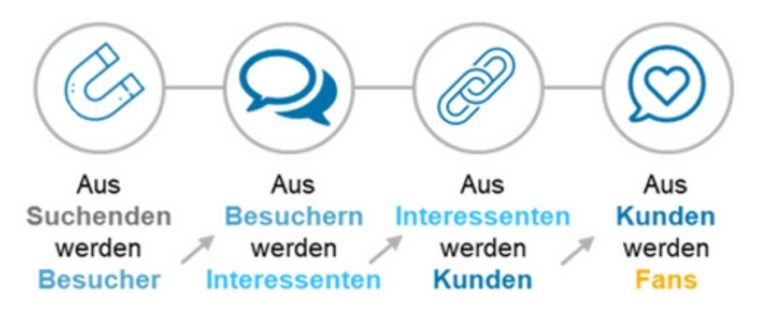
In order to successfully implement the inbound methodology in your company, you must align your entire corporate strategy with this methodology.
the company website works as central hub, about which relevant data is collected and processed as digital customer profiles in a central platform. Your potential customers go looking for solutions to their problems and very often they do so on the internetsearch engines. Here, it is crucial to know the relevant keywords of your target groups and to take them up on your website.
Social networks are used for communication between you and your prospects. You should use this to provide your potential customers with content that is relevant to them. You build up personal and corporate branding and thus appear as an expert. You have already drawn the attention of your prospects to you and now you can certainly attract themblogson your website with additional industry knowledge.
Make your website the focal point of your in bound strategy and grab tons of new leads.

With trend analyzes and specialist publications, you strengthen your expert role and assume a pioneering role. You offer the content provided, such as a white paper on a specific topic, for download on your website. For this purpose, your prospect lands on a linked landing page, where he has to enter his data such as name and e-mail address for the desired content.
You can your leads then automatically via that CRM system, which processes and stores the data, with a follow-up email and thematically in interaction to step. Responsibilities and tasks can be easily distributed between marketing, sales and service departments.
Look forward to cross-departmental interaction with prospects, which is carried out by marketers, salespeople or service employees, depending on the qualification level of the lead. The necessary information about your leads is stored centrally in your "living" CRM system.
The website as the linchpin is shown somewhat more abstractly in the following graphic. In this case it is a network of transportation around a place. Comparable to a large international hub, travelers arrive at a hub that has been created via various routes. It is important here to form the link to all “means of transport”.
In our digital case, you want to drive visitors to your website via search engines, social networks, blogs, and landing and thank-you pages Turning visitors into interested parties with targeted and value-added content.
Use the gigantic potential around this hub and grab leads that you can then develop using the following methods.
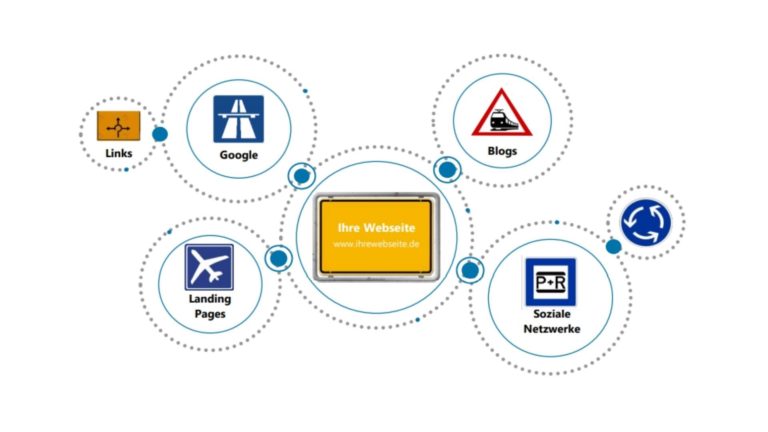
Methods for customer development
There are various methods along the customer journey to accompany your prospects in the search for a solution and in the decision-making process.
In the awareness phase, for example, about Social Selling, Search Engine Marketing or content marketing, Generates attention and generates visibility. Once the so-called lead has been identified, you can go through it lead nurturing Qualify measures further and use them with targeted, helpful content.
By a freely definable scoring model Leads can be evaluated based on their characteristics (e.g. industry, location or number of employees) and automatically clustered according to their attractiveness for your company. This allows you to use the data available from the digital profiles in this early phase and ensure that only qualified contacts are passed on to your sales department.

Email Sequences and meeting links are digital methods that reduce your personal administrative effort and help you to get in touch with your prospects as quickly and easily as possible. Account Based Marketing& Sales (abbreviated to ABM) is a strategy that aims to convince selected customers of your offer through strategically tailored campaigns. The target companies (accounts) are viewed as separate markets.
But even after the purchase, it is crucial to continue to support the customer and possible Cross- and upselling potential to use. Knowledge databases or ticket systems integrated into the CRM are some examples to support sales and customer service.
It is crucial for the sustainable success of your company that marketing and sales act as a team and pursue common goals:
New team spirit between marketing & sales
• Measurability through common goals, success factors and processes
• Transparency & efficiency through common database & reporting
• Reduction of sales costs through efficient inbound acquisition
• Marketing as effective support for sales in achieving goals
• Result optimization through targeted customer contact & responsibilities across the entire sales funnel
Cooperation between the sales and marketing departments is the key to long-term success.
